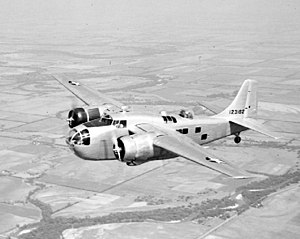avia.wikisort.org - Aeroplane
The Boeing AT-15 was an American twin-engined bomber crew trainer designed and built by Boeing's Wichita Division. Only two prototypes, designated XAT-15, were built. Plans to build over 1,000 were cancelled on the United States' entry into the Second World War.
| AT-15 | |
|---|---|
 | |
| Role | Bomber-crew trainer |
| National origin | United States |
| Manufacturer | Boeing Wichita |
| First flight | 1942 |
| Primary user | United States Army Air Corps |
| Number built | 2 |
Development
One of the first projects for the former Stearman Aircraft Company which in 1939 had become the Wichita Division of Boeing was a twin-engined trainer for bomber crews. Designated X-120 by the company, two examples were ordered by the United States Army Air Corps as the XAT-15. The AT-15 was a high-wing cantilever monoplane with two wing-mounted Pratt & Whitney R-1340 Wasp radial engines. It had a retractable tailwheel landing gear and an extended glazed fuselage nose for the trainee bomb-aimer. Due to shortage of materials, the aircraft was built of welded steel tube covered with plywood, with wooden wings and tail unit. The two aircraft were delivered to the USAAC, but after the country's entry into the war a change in priorities resulted in the planned order for more than 1,000 aircraft not being placed.
Operator
 United States
United States
- United States Army Air Corps
Specifications (XAT-15)
Data from [1]
General characteristics
- Length: 42 ft 4 in (12.90 m)
- Wingspan: 59 ft 8 in (18.19 m)
- Wing area: 457 sq ft (42.46 m2)
- Empty weight: 10,640 lb (4,826 kg)
- Gross weight: 14,355 lb (6,511 kg)
- Powerplant: 2 × Pratt & Whitney R-1340-AN-1 Wasp radial piston engine , 600 hp (447 kW) each
Performance
- Maximum speed: 207 mph (333 km/h, 180 kn)
- Range: 850 mi (1,368 km, 740 nmi)
- Service ceiling: 18,900 ft (5,760 m)
Armament
- 4 x 0.3in (7.62mm) machine-gun
- 10 x 100lb (45kg) bomb
See also
Related lists
- List of military aircraft of the United States
References
- Notes
- Orbis 1985, page 815
- Bibliography
- Taylor, Michael J. H. (1989). Jane's Encyclopedia of Aviation. London: Studio Editions.
- The Illustrated Encyclopedia of Aircraft (Part Work 1982–1985). Orbis Publishing.
External links
На других языках
[de] Boeing-Stearman AT-15
Die Boeing-Stearman AT-15 (Werksbezeichnung X-120, inoffizieller Beiname Crewmaker) ist ein militärisches Schulflugzeug des US-amerikanischen Herstellers Boeing, der dieses Baumuster in seiner Stearman Division entwickeln und fertigen ließ. Das Flugzeug war für die Schulung von Bomben- und Bordschützen vorgesehen.- [en] Boeing XAT-15
[fr] Boeing XAT-15
Le Boeing AT-15 est un bombardier d'entraînement à bimoteur américain construit par Boeing. Seuls deux prototypes ont été construits et ont été désignés XAT-15. Au départ, il était prévu que 1 000 avions soient construits, mais à cause de la Seconde Guerre mondiale l'achat a été annulé.Другой контент может иметь иную лицензию. Перед использованием материалов сайта WikiSort.org внимательно изучите правила лицензирования конкретных элементов наполнения сайта.
WikiSort.org - проект по пересортировке и дополнению контента Википедии